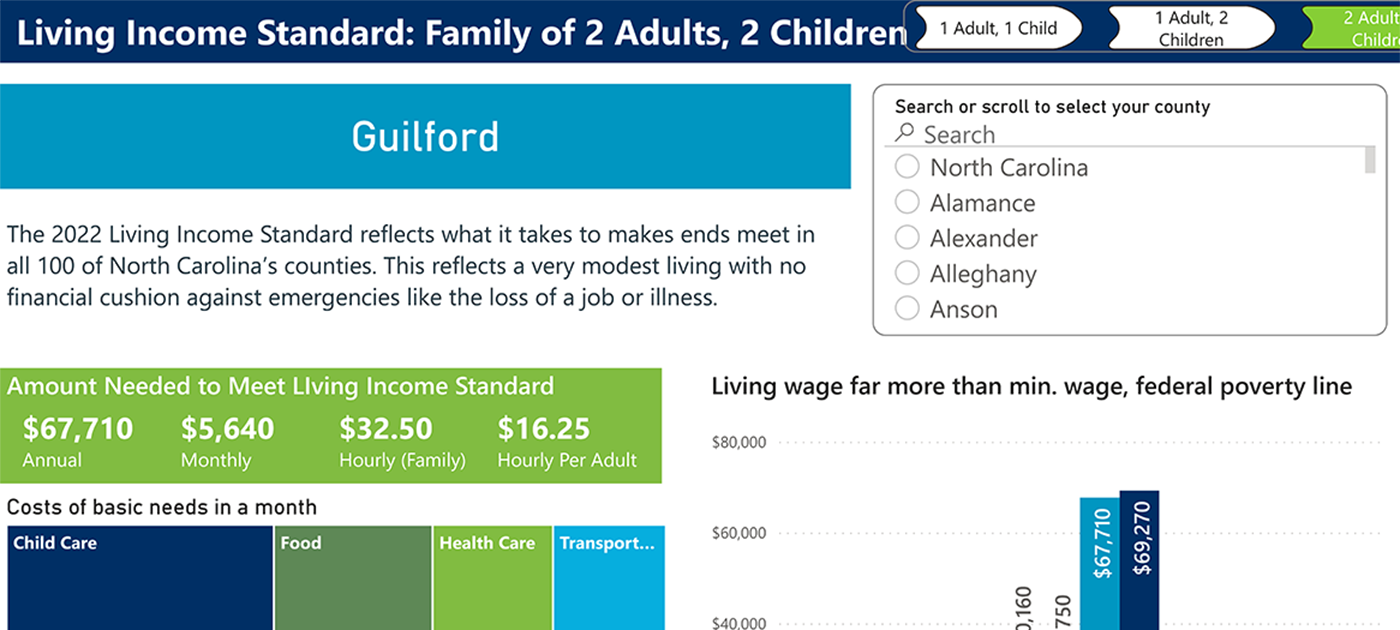
Here’s what it takes to make ends meet in your NC county
When COVID-19 arrived, few (if any) pundits predicted inflation would become one of the most fretted-over issues in 2022, but here we are. Supply chain disruptions, pent up demand, war in Ukraine, and myriad other factors have made it harder and harder for many working families to make ends meet. While the current moment is extraordinary, millions of North Carolina families found it hard or impossible to cover the cost of basic needs before the pandemic arrived.
Against this backdrop, we are releasing the 2022 Living Income Standard (LIS). The goal is to capture what it really takes to make ends meet in all 100 counties. The LIS is not living high on the hog — it’s a basic floor for what families need to get by. By that standard we’ve got a lot of work to do to keep working families from falling through the cracks.
See the Living Income Standard for your NC county
What is the Living Income Standard?
Relying on official federal and state data sources, the LIS calculates the cost of living based on eight household necessities: food, housing, child care, health care, transportation, miscellaneous costs, taxes, and debt payments. The result is a modest family budget that does not leave much room for the unexpected, like losing a job or illness.
LIS shows how woefully inadequate the official poverty level truly is
The LIS illustrates the gaping chasm between the official poverty line and what families need to make ends meet. When it was created in the 1960s, the poverty level was simply three times what the average family spent on food. That baseline hasn’t changed in nearly 70 years and has simply been adjusted to reflect the changing cost of food. As a result, the federal poverty level radically understates the number of families who don’t make enough to support a basic standard of living.
The official poverty line for a family of four is just over $2,300 per month. That’s roughly enough to pay for only housing and childcare, leaving nothing for transportation, food, health care, taxes, or debt payments. Inadequate wages force families to choose between rent and food, between clothes and gas, between child care and health care, and other brutal trade-offs that undermine their ability to thrive.
LIS won’t deliver real economic security
The LIS is a financial floor, not what it takes to create real economic security. Throughout the analysis, conservative choices were made to produce a basic standard for covering the cost of necessities — in other words, not enough to buy a house, take vacations, eat out, cover unexpected bills, save for retirement, pay for college tuition, or the many other things that go into real economic stability.
Both the Economic Policy Institute (EPI) and the Massachusetts Institute of Technology (MIT) produce similar measures of what a basic income needs to be, and both are substantially higher than the LIS. Take Iredell County, for example, which is roughly equal to North Carolina’s average LIS. A family of four would need to earn just under $70,000 according to the LIS, but would need to bring in north of $80,000 according to EPI and nearly $100,000 based on the MIT analysis. Even these other calculations don’t allow for real wealth building, but they do reflect just how conservative the LIS approach really is.
Minimum wage shockingly far from a living income
After not moving for more than a decade, the $7.25 federal minimum wage is insultingly inadequate. A single parent with one child would need to work 121 hours a week at minimum wage to meet the LIS in North Carolina. That’s the equivalent of working over 17 hours a day, leaving only 7 hours for everything else. Even for families of four, both parents would need to work more than two full-time minimum wage jobs to cover the cost of basic necessities.
Of course, no one can continually work these kinds of hours without sacrificing their health, parenting, connections with loved ones, sleep, and most of what we value in the human experience. By keeping the minimum wage so low, we essentially condemn working people to either working beyond human endurance or seeing their families go without what they need.
Following economic opportunity has a high price tag
A living income depends a lot on where you live. The fastest growing metropolitan areas, which have also been quicker to recover jobs lost to COVID-19, are precisely where making ends meet is the hardest.
On the other end of the spectrum, many of the most affordable counties struggle to generate enough job opportunities to sustain working families. Four of the five counties with the lowest LIS are among the places that still have not recovered jobs lost during COVID-19. More broadly, many of the counties that never recovered from the Great Recession are also have the lowest cost of living.
This creates a huge dilemma for many working families: Following job opportunities often means living in the most expensive places in North Carolina.
LIS underscores the need for a new economic deal
By itself, the LIS is just facts and figures. The real goal is helping working families to document the story of what they face on a daily basis and set a benchmark for what a basic income needs to be. As prices for many basic necessities continue to climb, the need to raise wages for millions of North Carolina families becomes increasingly pressing.




